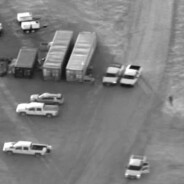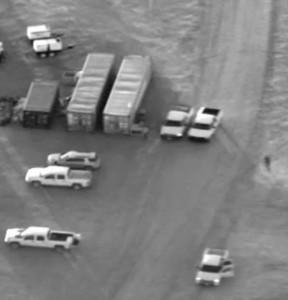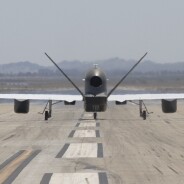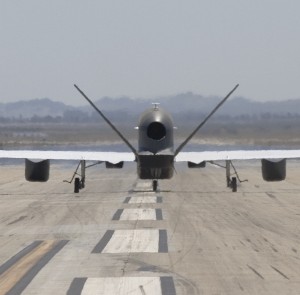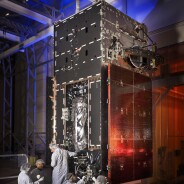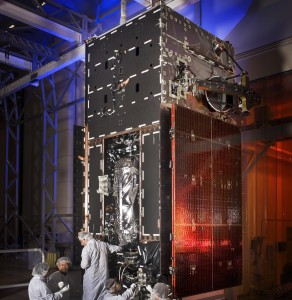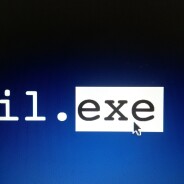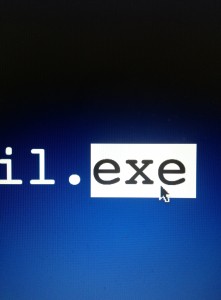Features
After Boston, new motivation for surveillance techies
Even before the Boston bombings, the Air Force Research Lab in Rome, New York, was trying to figure out how to stitch together imagery and video from disparate sources, and give analysts the software tools to make sense of the information.
The attack at the Boston Marathon is now hot on the minds of officials in Rome, where the main customer is the military, but processes are in place to share technologies with other agencies.
“Look at Boston,” said the lab's Frank Hoke. His role is to foster technical collaboration among the Air Force, private companies, universities and other agencies, including the Department of Homeland Security. “How do we make things faster? How do we make decisions faster?” he said.
Investigators in Boston were faced with a torrent of imagery, including surveillance video, smartphone images, and Facebook postings. The military faces a similar fusion challenge in war zones.
One kind of imagery the Boston investigators didn’t have, as far as we know, was wide area surveillance imagery from drones or aerostat balloons. When a bomb goes off in range of one of these cameras in Afghanistan, the military runs the city-sized snapshots in rewind mode in hopes of tracking bombers back to their lairs. The military wants to do more than that, and Rome lab wants to be on the cutting edge of the work.
“The desired end state is to move away from a forensic analytics push to a predictive analysis piece,” said Frank Purdy, director of national security services for Logos Technologies in Arlington, Va.
The idea is to automatically alert analysts to suspicious activity in one corner of a vast image. The analyst would study the scene with other intelligence collections to figure out what the people in the image are about to do next.
Logos makes the Kestrel wide area cameras that are flown on aerostats in Afghanistan. By June 1, Rome is scheduled to get a fresh supply of archived wide area imagery from Logos under a cooperative research agreement reached before the Boston bombings.
One of Hoke’s jobs is to transfer technologies for domestic use. Will the military’s wide area surveillance technology be next?
Hoke doesn’t know, but he said any such transfer would be done thoughtfully.
“We know about Posse Comitatus,” he said, referring to the 19th Century law that prevents the federal military -- although not state-run National Guard units -- from being used domestically. “We can train people to do stuff, we can give people technology, but we cannot be sitting there,” he said.
Logos and the Air Force are waiting for the information assurance approvals that would let them get to work with the data and software tools.
No money will change hands under the cooperative agreement: The Air Force gets wide area imagery, and Logos gets broader visibility for the analytical tools it develops.
One of those tools lets analysts draw watch boxes onto their screens.
“If people move in and out of that scene, if there’s a significant event inside of that scene, that will cue the analyst to move his view to that exact location and zoom in to evaluate what’s going on,” said Purdy.
Deep Dive spoke to Purdy before the Boston bombings, and at that time he was cautious about domestic applications, pointing mostly to border surveillance as a possible use.
“Everybody has their right to privacy, and we believe in them very strongly,” Purdy said. “We as a country. We as a company and me as an individual.”
But border states like Texas “have a lot of concern for the safety of their citizens when it comes narcotics operations, drug smuggling, and a host of other things. Why wouldn’t we want to share this capability, this technology?” he added.
Liberty versus security in Boston
We’re going to need to come to grips with the appropriate role of surveillance in our society. That’s one lesson from the bombings at the Boston Marathon.
We’ve spent billions in Afghanistan on eavesdropping equipment, wide area surveillance cameras, and cellphone tracking technologies to find improvised explosive devices and the people who plant them. It’s a problem similar to the one the FBI and Boston police are facing.
Makeshift bombs still go off in Afghanistan, but the toll would be far higher without surveillance data and the intelligence analysts who make sense of it all.
It’s time for us to decide which of these skills, devices and software can be applied at home and under what circumstances, while still keeping America America.
The country has been in a tug-of-war between liberty and security ever since the Sept. 11 attacks.
“The balance swung yesterday for sure,” said Brad Barker, president of the HALO Corporation, a California-based security firm.
The question is how far the pendulum should be allowed to swing. Even the most ardent intelligence and security advocates fear to think where too much zeal could lead us:
“There will be times when you make the choice: We’re going to be a little less safe because we’re not going to go do that,” former CIA and NSA director Michael Hayden said in a February speech.
In the wake of the Boston attacks, the country needs to get to work on a national strategy for domestic surveillance of large events. The strategy needs to be genuinely transparent, it should have well-defined limits, and it should spell out coordination with state and local jurisdictions.
In the years since Hurricane Katrina, the federal government and local jurisdictions have learned to coordinate well on disaster response. They can do the same on intelligence and surveillance.
Compromises are going to be required, that's for certain. Flying wide area surveillance cameras over major cities 365 days a year would be impossibly expensive, even if it were in our national character. But doing that for major events like the Boston Marathon is starting to sound more like prudence than a violation of our civil liberties.
Where would the money come from? We're spending billions on warplanes that will never go to war, missiles that will never be fired, and radios that do a smidgeon of what the phone in your pocket can do. We could find the money if we wanted to. The calculation is a cold one: How much should we spend securing crowds from what are likely to remain rare attacks?
As for civil liberties, somehow we’ve put ourselves in a situation where city governments routinely give out traffic tickets based on the views from cameras, and yet the idea of the government flying cameras overhead is somehow taboo. And so, investigators in Boston are reportedly left to stitch together video clips from cameras on buildings or those carried by bystanders.
At some point, the liberty to attend a sporting event outweighs the discomfort of knowing you’re being watched.
We need a domestic security strategy and we need it quickly, partly because the threat is here and now, and partly because decisions must be made about which intelligence, surveillance and reconnaissance technologies should become our spending priorities in the post-Afghanistan era.
Before the Boston bombings, intelligence and security companies were trying to shoehorn their way into homeland security applications, but mostly for border monitoring or to find drug smugglers in the Caribbean. Few have wanted to touch the hot-button issue of surveillance over major American cities.
Not all the techniques used in Afghanistan can or should be adopted domestically. In the war zone, eavesdropping on cellphone calls and pinpointing the locations of the people using them are regular parts of business. Those can't be done routinely here, and the level of risk doesn't justify it. But wide area surveillance cameras would be less intrusive and more transparent. You'd see the tethered aerostats or drones carrying them.
These cameras generate images of city-sized areas a few times a second. When a bomb goes off in Afghanistan, experts run the motion imagery backwards and try to figure out who planted the bomb.
Forensics is one thing. Better would be to detect suspicious activity in time to stop it, either through intelligence collections or surveillance closer to an event. With wide area surveillance, that would require software to automatically alert security personnel or analysts. The areas are just too vast for analysts to monitor in real time.
Is homeland security one reason to invest in automation software that might solve that problem?
A national plan for domestic surveillance would tell us.
U-2 cameras on Global Hawks? — some like the idea
The rap against the Block 30 versions of the Global Hawks has been that they can't steer around typhoons, and their cameras lack the range of those on the traditionally-piloted U-2 planes.
So why not move Senior Year Electro-optical Reconnaissance Systems off the U-2s and onto the Block 30s and upgrade the planes to avoid or cope with severe weather?
Northrop outlined those ideas in Feb. 8 letter from CEO Wes Bush to the Air Force brass. The company has taken a lot of heat for cost overruns on the Global Hawk program, and this time it says it's willing to do the work under firm-fixed-price contracts.
For $48 million, Northrop says it can equip six of the service’s 18 Block 30 Global Hawks with existing SYERS-2A cameras. For $7 million more, it can equip three of the planes with a solution for the weather problem. Northrop would accept the same $258 million a year to keep the planes flying, even if the contract length were cut back from 10 years to five.
The Northrop proposal is the latest volley in the company’s battle to save the Block 30 planes from the Air Force’s budget knife. The Air Force says it wants nothing to do with the Block 30s after 2014, because of their troubled history, and the fact that the Pentagon has scaled back its official requirement for spying from high-altitude aircraft.
Neither the Global Hawks nor the U-2s can do what the intelligence community really needs them to do, which is peer deep inside Iran, an Air Force official said. The only solution for that would be “National Technical Means” – a euphemism for spy satellites -- the official said.
Nevertheless, Northrop’s proposal to improve the Block 30s is getting traction on Capitol Hill, judging by an April 12 congressional hearing.
“I personally believe that there are common sense improvements that enhance the Block 30 utility,” said Rep. Madeleine Bordallo, a Democrat from Guam, where Global Hawks are flown from. She was seconded later by Rep. Rob Bishop, R-Utah, who advocates continuing to fly both the U-2s and Global Hawks.
The reception from the Air Force was less than warm: “This remains a difficult area,” Air Force Secretary Michael Donley responded.
Behind the scenes, Northrop has been working to build support among lawmakers, their staffs, and Air Combat Command. “That’s fine, that’s what they do,” an Air Force official. “It hasn’t changed the position of the Air Force yet.”
Some lawmakers were flabbergasted in January 2012, when the Air Force did an about-face and said it wanted to cancel the Block 30 program and put the planes in storage. Only months earlier, the Pentagon had re-certified the over-budget planes as critical to national security, a requirement for continued funding under the Nunn-McCurdy cost control law.
Gone phishin’ – exec tests employees from vacation spot
This sounds like a good gig if you can get it. Go on vacation to a Caribbean island, and then punk your employees back home with a fake email about the income tax returns many of them are no doubt stressing over.
That’s what Northrop Grumman’s Michael Papay did a few weeks ago to his company’s 68,000 employees.
The email was no joke. Papay is Northrop’s vice president for information security, and he wanted to remind employees that security starts with them.
Judging by the buzz among Northrop employees, it worked.
Papay revealed the fake spearphishing attack April 3 during a cybersecurity workshop held by the National Institute of Standards and Technology. The email’s subject line told employees that their 2012 tax returns needed to be adjusted. Tests like that are something the company does from time to time.
“It’s everybody’s job to consider the risk to the company when they click on that link, when they open that email,” Papay said.
Employees who reported the email to Papay’s Cybersecurity Operations Center got a “nice thank you email from me that says, ‘Hey, good job – way to pay attention,” he said. Those who fell for the trap got “remedial training,” he said.
NIST explains Obama’s cyber framework
President Obama’s forthcoming Cybersecurity Framework won’t create an entirely new set of standards for banks, defense companies, and other members of the critical infrastructure, the director of the National Institute of Standards and Technology said today.
The framework “is basically going to be a collection of, probably references to existing standards,” said NIST Director Patrick Gallagher.
Obama’s Feb. 12 executive order directed NIST to produce a framework of “voluntary consensus standards” for members of the critical infrastructure to follow.
Regulation-wary executives weren’t sure whether that meant entirely new standards would be crafted in the span of the order’s 240-day timeline for producing a first draft of the framework.
The framework is one element of a shift in cybersecurity strategy by the White House. Attempts to improve cybersecurity through legislation have failed repeatedly, so the administration wants to push the private sector to agree on a common set of voluntary security standards that would be regularly updated.
NIST plans to drive the process, but says it wants input form the industry and outside experts about the technologies and practices that should be included in the framework.
Companies and universities have until April 8 to respond to a request for information. Workshops with the industry are also planned, including today’s at the Commerce Department headquarters in Washington, D.C.
“This is the last workshop where we will sit and talk at you,” said Matt Scholl, deputy chief of NIST’s Computer Security Division.
The next workshop is scheduled May 29 - 31 at Carnegie Mellon University in Pittsburgh.
Excerpts from the workshop >>
Complacency >> “I also worry a little about whether we’re setting a false sense of security by saying here’s a framework: Follow the framework and you’re going to be secure.” -- Scott Algeier, executive director of the Information Technology Information Sharing and Analysis Center
Information sharing >> “We absolutely need a better mechanism for getting actionable intelligence into our companies. I think the ISAC mechanisms are the right approach to that.” -- Terry Rice, chief information security officer, Merck & Co.
Vulnerable vendors >> “If our adversaries are all trying to attack tier 1 integrators, and you realize, wow, these guys are really up on their game; they know where the threats are coming from; they beat us every single time, (adversaries will) move down the chain.” – Scott Algeier
Collateral damage >> “The whole concept of the doctrine of cyber warfare is still being written. We don’t know how to behave in a cyber conflict – we nation states, where the power system, the water system, the health system and others are getting collateral damage.” -- Tim Roxey, chief cyber security officer at the North American Electric Reliability Corporation.
Gallagher on the framework >> “The framework itself, as I said, is basically going to be a collection of, probably references to existing standards. By the way, there may be more than one in different areas. The U.S. standards process is wonderfully competitive. We often have lots of options there. There’s no reason we have to walk away from that.”
OPINION: Time to buy smarter — here’s how
Given the country’s budget outlook, the Defense Department now has no choice but to improve its acquisition performance. But how to do get it done?
We recently addressed that question for our firm, A.T. Kearney.
We compared the defense sector’s acquisition track record and decision processes to those of the private sector. The results were illuminating, and they suggest that the defense sector should look to the commercial world for lessons.
Our complete findings can be found in the white paper, “The Value of Time Matters,” on the A.T. Kearney web site.
We knew going into our study that the commercial world is widely assumed to do a better job of buying big ticket items like aircraft and satellites. We wanted to see how much better.
We examined the acquisition cycle times for seven of the Defense Department’s top aircraft programs and five of its satellite programs. Acquisition cycle times were defined as the number of months from award of a program contract to declaration of initial operational capability. We then compared the military’s cycle times to commercial fielding times for three kinds of airliners and 11 commercial satellites.
The averages told the story. It took the military nearly twice as long to start operating a new kind of aircraft as it did the commercial sector. The military averaged 114 months, compared to 64 months for new commercial airliners, or a 178 percent difference.
The numbers were even more stark for satellites. The military needed 6.9 years on average to bring satellites into operation, compared to 3.1 years in the commercial world – a 223 percent difference.
It’s true that military aircraft and satellites are typically more sophisticated than their commercial counterparts. But they’re not so much more sophisticated that it should take twice as long to develop and build them. On top of that, defense acquisition planners shouldn’t be underestimating acquisition cycle times by 30 percent, as we found they routinely do for aircraft programs.
Something is amiss. How can it be that the same companies that manufacture airplanes and satellites so efficiently for the private sector are so late for the defense sector?
The root of the problem is this: The commercial world is highly sensitive to the cost implications of time. Congress and the Defense Department are not. Commercial companies know they must minimize technical risks, resist the urge to add new capabilities, and limit reviews to those that are absolutely necessary. There is a tangible opportunity cost of not getting a plane or satellite in service on time, and a penalty in the market for being late.
As a result, the commercial world has a built in incentive to put decision makers in one room and make decisions in a highly-regimented, time-boxed, gated approach. In the defense sector, everyone gets a say: the program executive office; the service acquisition chief; experts in the defense secretary’s office; plus multiple committees on Capitol Hill. This review and approval chain stretches acquisition times, which drives up costs, but in government, there is no marketplace imposing penalties for delays, and nobody in the chain is accountable for the resulting cycle-time induced cost increases.
Officials in the Defense Department and in Congress know this structure is too cumbersome. Changing it would be hard, and so each authority tries to fix troubled programs by digging into them. Reviews are ordered. Budgets are adjusted. Schedules and requirements are changed. The inefficient process that produced the delay in the first place now has the added burden of incorporating changes and writing reports for reviewers.
Our paper describes reasonable changes the Defense Department and Congress should make to reflect the more efficient processes of the commercial world. Our proposals span from incentives to shifts in authority.
We are not saying that every defense Acquisition Category 1 program can be compressed to the commercial sector’s timeline. Military aircraft and satellites may always take longer to build due to their complexity. But twice as long? That’s not an option in this market.
Randy Garber is an A.T. Kearney partner in the Aerospace and Defense and Public Sector Practices.
Arash Ateshkadi is a management consultant with A.T. Kearney. He has a Ph.D. in mechanical and aerospace engineering.
Computing with DNA and other wild ideas
IARPA says bring 'em on
The intelligence community's research shop wants to see if DNA, lightwaves or other phenomena can be harnessed into computers that would rip through big data sets dramatically faster than today’s machines or those on the horizon.
Scientists in the U.S. and abroad have until April 5 to chime in about their work and its potential relevance to intelligence problems. IARPA released the “Novel Technologies for High Performance Computing” request for information on March 8.
If the ideas look promising, they could lead to a new research program and another step in IARPA's effort to push scientists and the industry to do more than squeeze more circuits onto chips.
IARPA has been pushing the computing envelope for a while. It's already funding quantum computing research, including work by Nobel laureate Dave Wineland at the National Institute of Standards and Technology in Colorado, and it's exploring superconducting computing under a program called C3 for Cryogenic Computing Complexity. Next, it wants to see if entirely new concepts can help with problems like big data. The community is accumulating huge data sets, and it's going to need more and more computing power to find nuggets of critical information in those troves.
One problem for IARPA is that research on exotic concepts is scattered among numerous agencies, corporations, and universities in the U.S. and abroad.
“We don’t know the state of the art – or the state of the science actually – in these other techniques,” said IARPA Director Peter Highnam. “We’re asking both about the technologies and we’re asking about the types of applications that technology might do well at.”
IARPA plans to evaluate the responses and then possibly issue a broad agency announcement kicking off a competition for funds.
Highnam isn’t sure when that might be given the continuing resolution the government is operating under, and sequestration.
“It won’t be tomorrow,” he said. “I don’t want to try to speculate.”
IARPA’s brainiacs spend a lot of time reading scientific papers, and one of the motivations for the novel technologies initiative was a 1994 paper by Leonard Adleman. He’s the A in the RSA encryption algorithm that protects transactions over the Internet. In the paper, Adleman described using strands of DNA to perform an algorithmic computation.
Highnam and his colleagues decided IARPA should learn more about DNA and other wild concepts for processing information.
Just as in the C3 superconducting program, IARPA wants to look beyond what Highnam calls the “CMOS juggernaut.” That’s a reference to the complementary metal-oxide semiconductors inside today’s graphics processing units. GPUs are great at quickly rendering three-dimensional graphics in video games, but entirely new kinds of processors might be better at plowing into big data or other intelligence problems.
Why hasn’t old-fashioned free-market enterprise brought new approaches to the market?
Highnam thinks computer designers have been doing the equivalent of teaching to the test. Winning new business means climbing up the industry’s official “TOP500” performance rankings, and to do that a computer must score high on the industry’s official computational yardstick, known as the LINPACK Benchmark.
If getting ahead comes “via the LINPACK benchmark, then you’re going to build systems that do really well on the LINPACK benchmark,” Highnam said.
The rub is that entirely different kinds of computers might open the door to new applications. The LINPACK results are “relevant and really good -- if you’re interested in primarily physics, or 3-D physics, simulations and analysis, which is where that type of math came from,” Highnam said.
‘Lid comes off’ cyber espionage fight
On site with General Dynamics Fidelis Cyberscurity Solutions
China has allegedly been planting executable code into American businesses from a 12-story military building in Shanghai, where members of the People’s Liberation Army must be getting tired of chasing away photographers and reporters. America’s private-sector cyber forensic experts work in humbler settings. One is a ground-level suite inside a suburban Maryland office building about seven miles from the National Security Agency.
Inside is a small lab where 15 forensic experts dig into corrupted corporate hard drives and samples of malware code. The lab is part of General Dynamics Fidelis Cybersecurity Solutions, a subsidiary of General Dynamics formed last year when the defense giant bought Fidelis, a 70-person security software firm in Waltham, Mass.
No one’s chasing reporters away from this Marlyand office. In fact, the company recently invited reporters to come in, ask questions and watch a lab version of last year's Shamoon virus wipe data from a laptop computer. Quiet days are almost unheard of in the cybesecurity world, and sure enough members of the team were up late analyzing a sample of the code that struck thousands of computers at South Korean banks and broadcasters. They put out an advisory on their Threat Geek blog saying the wiped data was recoverable.
GD Fidelis and its competitors are on the frontline in the corporate world’s battle against cyber espionage and sabotage by criminals and nation states. The battle has been a quiet one, but that’s changing and partly because of one of GD Fidelis’ competitors, the 300-person Mandiant company of Alexandria, Va.
Mandiant cleaned up the hacking mess at The New York Times in November and then outed the Shanghai building in a 76-page page report alleging Chinese cyber espionage going back years.
After the Shamoon demo, reporters sat down with GD Fidelis executives to talk about cybersecurity. If GD Fidelis is feeling scooped by Mandiant, the executives give no hint of that. In fact, they described the Mandiant report as a welcome turning point away from the corporate secrecy that has hampered the sharing of threat intelligence.
“All of the sudden, you know, it’s not the scarlet letter to be compromised,” said Peter George, who was CEO of Fidelis and is now president of GD Fidelis. "The Mandiant report, right, kind of took the lid off this particular issue," he added.
George has been working closely of late with veteran General Dynamics executive Jim Jaeger (say Yaeger), a retired Air Force brigadier general and former NSA operations deputy. Jaeger’s forensics team is now sharing threat intelligence with designers of Fidelis’s malware-blocking XPS security software, which GD Fidelis says is being tested by companies in the Persian Gulf in the wake of the Shamoon wiping attack against the Saudi Aramco oil company.
“Jim (Jaeger) and I have been to eight Fortune 100 companies in the last three weeks because this is a boardroom issue now,” George said. “Everybody’s talking about it, everybody wants to share information on how do we deal with this national security problem -- protecting intellectual property.”
If the cyber community is in the midst of a sea change, it’s one that arguably began on Jan. 30, when the New York Times described how and why 53 computers at various Times sites were broken into, allegedly by China. Times executives then did something corporate espionage victims aren't known to do: They freed their hired forensics gun – Mandiant -- to talk to the media, including Deep Dive.
The way George sees it, all the hubbub from the Times and other breaches could help in the battle against “advanced persistent threats,” malicious code that hides in computers and secretly exfiltrates data. With secrecy less of an issue, momentum is growing for better collaboration between the government and private businesses.
George said there was electricity in the air at the late February RSA security conference in San Francisco. “People were talking about APTs four years ago out there, but it was always a whispering in the back room. Customers didn’t really want to talk about it,” he said.
The shift could be good news for General Dynamics, which does a lot of work for the National Security Agency and also for commercial businesses.
“We have this unique opportunity to reach across General Dynamics into some of the organizations that have been dealing with this cyber threat, leave the classified information there, but bring this into our commercial customers,” he said.
IC’s computing revolution falls behind schedule
DIA cites complexity of desktop testing
Overhauling the way the intelligence community stores and shares internal information sounded hard, and evidence is mounting that it will be.
The community wants to give intelligence workers a new operating system and desktop computing environment so they can easily shift among work sites and offices. The IT side of the house would save millions by getting out of the business of maintaining separate desktops at multiple agencies.
The desktop will be the front end of the community's bold information modernization plan, called ICITE (pronounced eyesite), which is short for Intelligence Community Information Technology Enterprise.
Testing is turning out to be harder than envisioned, and the schedule is beginning to slip. An initial version of the desktop environment, or DTE, is undergoing 300 separate tests for function and security. The ability to send and receive encrypted emails needs to be verified by a "placebo" user group, as does the desktop's classification tool, its Microsoft SharePoint capability and many other functions.
Once the tests are complete, switching users over won't be like flipping a light switch. Users will keep using their old desktop while running the new one for a while. A User Transition Planning Team has come up with a "170-day model to provide seamless user migration," according to a prepared statement from DIA, which has been assigned the lead role on the desktop work.
DIA turned aside interview requests, but an agency official was put on the hot seat about the status of the desktop during an industry luncheon. He said the community won't be able to meet the March target for having the desktop running at DIA and NGA, which would constitute initial operating capability.
“The IOC piece” – initial operating capability – “it’s slipped and stuff. It’s the testing,” said Gus Taveras, the chief technology officer at DIA.
The idea is to install the desktop gradually across all 17 agencies under an acquisition plan still to be determined.
By turning to a common desktop, cloud computing, apps and widgets, the community hopes to reduce IT spending by 20 percent by 2018. Intel budget wonks have been counting on those savings to ease the pain of the Obama administration’s plan to scale back intelligence spending dramatically in the coming years.
With the desktop in testing, IT officials continue to push ahead on other aspects of the modernization plan.
Taveras said that he’ll have a software development kit, or SDK, ready for industry developers in 30 to 45 days. If all goes as planned, developers will flock to create desktop apps and widgets that the community’s analysts would choose from in an online applications mall populated with stores from various agencies.
The idea is to put the decisions in the hands of analysts. “You get away from this anointed leader picking, ‘Hey, I’m going to use your stuff, I’m going to use your stuff, I’m going to use your stuff,’” Taveras said.
Intelligence officials know they want to tie payments to the popularity of the apps and widgets, but they still need to figure out how to implement that concept, Taveras said.
Endit
Shifting intel cited in North Korea flip-flop
Once again, predictive intelligence has gotten it wrong, at least that’s how I read the words of two top Pentagon officials.
Back when President Obama decided to stop deploying interceptor missiles in Alaska and California, “we didn’t know that we would see today what we are now,” said James Miller, undersecretary of defense for policy, in a briefing at the Pentagon today.
What Miller and other officials are seeing is a more billigerent-sounding North Korea that has conducted a third nuclear test and continues work on long-range missiles.
In response, the U.S. now intends to deploy 14 additional interceptors at sites in the U.S. by the end of 2017. The U.S. already has 30 interceptors in place. Contractors will need to prove they've solved a technical problem with a new version of the interceptors before the 14 are bought, officials said.
The intention to deploy more interceptors was mainly a response to North Korea, but Iran is also on the minds of U.S. officials, said Adm. James Winnefeld, the vice chairman of the Joint Chiefs of Staff.
Winnefeld portrayed the administration's reversal as an example of flexibility in the face of evolving intelligence.
“We have continually built this hedge, a set of tools from which we can select if the threat either goes faster or slower than we thought. And so the Korean threat went just a little bit faster than we might have expected,” Winnefeld said.
So what is the assessment of North Korea's capabilities today? Winnefeld said there are “mixed accounts” about whether a long-range missile showed off in a Pyongyang parade last April was the real deal.
If the missile was real, it would be a danger, he said. “We believe the KN-08 probably does have the range to reach the United States. Our assessment of where it exists in its lifetime is something that will remain classified,” Winnefeld said.
The U.S. doesn’t seem to be in a huge rush, though. Miller said that about a billion dollars for the new CE-2 interceptors and other equipment will be included in the fiscal year 2014 budget that the administration has not yet sent to Congress.
More drama will be in store late this year when the Missile Defense Agency tests the fixes to the CE-2 interceptors. Winnefeld said a CE-2 will try to intercept a missile “hopefully this fall." The U.S. won’t buy the interceptors until the Pentagon has “complete confidence” in them, Hagel said.

